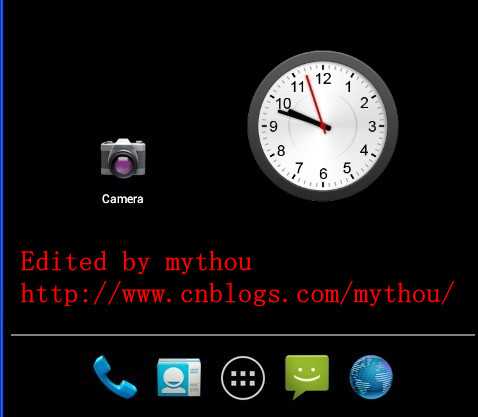标签:
前面已经写过Hotseat分析的文章,主要是讲解如何在Launcher里面配置以及修改Hotseat的参数。
今天主要是讲解一下如何在Hotseat里面的Item显示名称。
(PS:新建的QQ群,有兴趣可以加入一起讨论:Android群:322599434)
默认Hotseat里面的元素都没有标题

1.Hotseat隐藏文件夹标题
刚开始想解决这个问题的想法是找到按钮对象生成的地方,修改一下就好了。因为我上次分析Hotseat的时候,记得有一个地方把Hotseat的按钮文字屏蔽了,我想只要打开就好。
//Edited by mythou
//http://www.cnblogs.com/mythou/
if (container == LauncherSettings.Favorites.CONTAINER_HOTSEAT)
{
if(OWLLauncherDebug.HotSeat) Log.d(mythou, "addInScreen------->CONTAINER_HOTSEAT");
layout = mLauncher.getHotseat().getLayout();
child.setOnKeyListener(null);
//隐藏Hotseat里面文件夹的名称
if (child instanceof FolderIcon)
{
((FolderIcon) child).setTextVisible(false);
}
//.........
}
上面这段代码是在Workspace里面addInScreen()的部分代码,是绑定workspace元素的时候调用的方法,里面的确有一个判断是否隐藏文件夹的名称,但是没看到隐藏普通快捷方式的代码。
我先把文件夹标题隐藏的功能去掉,但是hotseat里面的文件夹还是没有名称。没办法,只能从头看看Hotseat上面那些快捷方式如何添加和加载。
2.Hotseat上Item如何生成
Hotseat上面的快捷方式可以分为两种,一种是普通快捷方式,可以在default_workspace里面配置。另外一个是全部应用列表的按钮,这个实在Hotseat.java里面动态生成的。我们先看看普通的快捷方式如何生成,一般的快捷方式,通过加载default_workspace,这个过程跟workspace上面的按钮一样,前面已经有详细分析,这里不多说。我们主要看看如何生成快捷方式的对象,其实这个跟workspace也是一样,我们看看下面代码:
//Edited by mythou
//http://www.cnblogs.com/mythou/
public void bindItems(ArrayList<ItemInfo> shortcuts, int start, int end)
{
//.........for (int i=start; i<end; i++)
{
//.........if(OWLLauncherDebug.HotSeat) Log.d("OWL_Launcher", "bindItems------->item="+item);
switch (item.itemType)
{
case LauncherSettings.Favorites.ITEM_TYPE_APPLICATION:
case LauncherSettings.Favorites.ITEM_TYPE_SHORTCUT:
//生成Item的View对象
View shortcut = createShortcut((ShortcutInfo)item);
//添加到对应的screen里面
workspace.addInScreen(shortcut, item.container, item.screen, item.cellX,
item.cellY, 1, 1, false);
break;
}
}
}
上面是Launcher里面的bindItems()方法的部分代码,bindItems()这个方法,看过我前面分析Launcher数据加载的朋友应该不会陌生,
这是绑定Launcher数据时候Launcher回调的一个方法,Hotseat的Item对象就在这里生成。调用了createShortcut()方法,下面我们看看createShortcut()是如何生成Item对象。
3.Item添加到Hotseat
//Edited by mythou
//http://www.cnblogs.com/mythou/
View createShortcut(int layoutResId, ViewGroup parent, ShortcutInfo info)
{
if(OWLLauncherDebug.HotSeat) Log.d("OWL_Lancher", "addInScreen------->info="+info);
//生成Item的快捷方式,Hotseat里面的按钮也是BubbleTextView
BubbleTextView favorite = (BubbleTextView) mInflater.inflate(layoutResId, parent, false);
favorite.applyFromShortcutInfo(info, mIconCache);
favorite.setOnClickListener(this);
return favorite;
}
从这里可以看出,其实Hotseat里面的按钮也是BubbleTextView的对象,也就是跟一般的workspace里面的按钮一样。对象生成以后会添加到对应的Screen里面。前面Hotseat的文章我也说过,Hotseat其实也是一个CellLayout的screen。在程序里面是标记为最后一个screen。
4.Hotseat的AllAPP按钮
//Edited by mythou
//http://www.cnblogs.com/mythou/
void addInScreen(View child, long container, int screen, int x, int y, int spanX, int spanY,boolean insert)
{
if(OWLLauncherDebug.HotSeat) Log.d(OWL, "addInScreen------->screen="+screen);
final CellLayout layout;
//针对Hotseat的对象做特殊处理 mythou
if (container == LauncherSettings.Favorites.CONTAINER_HOTSEAT)
{
if(OWLLauncherDebug.HotSeat) Log.d(OWL, "addInScreen------->CONTAINER_HOTSEAT");
layout = mLauncher.getHotseat().getLayout();
child.setOnKeyListener(null);
//隐藏Hotseat文件夹标题
if (child instanceof FolderIcon)
{
// ((FolderIcon) child).setTextVisible(false);
}if(OWLLauncherDebug.HotSeat) Log.d(OWL, "addInScreen------->CONTAINER_HOTSEAT screen="+screen);
if (screen < 0)
{
screen = mLauncher.getHotseat().getOrderInHotseat(x, y);
}
else
{//获取child的位置,返回true添加成功,false失败 这里其实是Hotseat里面Item的位置
x = mLauncher.getHotseat().getCellXFromOrder(screen);
y = mLauncher.getHotseat().getCellYFromOrder(screen);
}
if(OWLLauncherDebug.HotSeat) Log.d(OWL, "addInScreen-------> x="+x + " y="+y);
}
}
上面就是把Hotseat里面元素添加到Hotseat对应的CellLayout里面去,里面有一部分针对Hotseat元素的特殊处理,也就是刚开始说的隐藏文件夹标题以及技术元素位置的代码。除了这些,我并没有找到隐藏按钮文字的方法。后来只能看看Hotseat里面另外一个按钮(AllAPP)能不能显示文字。
4.Hotseat的AllAPP按钮
//Edited by mythou
//http://www.cnblogs.com/mythou/
void resetLayout()
{
//清空Hotseat里面所有的元素
mContent.removeAllViewsInLayout();
//添加ALLAPP按钮
Context context = getContext();
LayoutInflater inflater = LayoutInflater.from(context);
//修改为自己定义的button配置application, mythou
BubbleTextView allAppsButton = (BubbleTextView)
inflater.inflate(R.layout.application, mContent, false);
//设置allapp按钮的图片
allAppsButton.setCompoundDrawablesWithIntrinsicBounds(null,
context.getResources().getDrawable(R.drawable.all_apps_button_icon), null, null);
allAppsButton.setText(context.getString(R.string.all_apps_button_label));
allAppsButton.setContentDescription(context.getString(R.string.all_apps_button_label));
int width = allAppsButton.getWidth();
int heigh = allAppsButton.getHeight();
Log.d("OWL_HOTSEAT", "allAppsButton width="+width+" heigh="+heigh);
//.........
}
5.Hotseat显示Item标题
前面说了半天都没说到如何修改显示标题。其实这个说起来很简单,Hotseat里面的元素,每个都保存了Item的标题,我还特意把数据打印出来看了,因为刚开始以为系统直接把标题数据删除了。之所以没有显示出来是因为Hotseat设置的高度太低,导致标题部分显示被屏蔽了,很实用也很囧的方法。另外可能会有人要问,既然从显示空间上限制了,为何还要加个判断文件夹标题隐藏?这个问题答案,只要你看看文件夹高度就知道了,自己实践一下才能印象深刻。
转载地址:
http://www.cnblogs.com/mythou/p/3211443.html
标签:
原文地址:http://www.cnblogs.com/cyqx/p/4778931.html